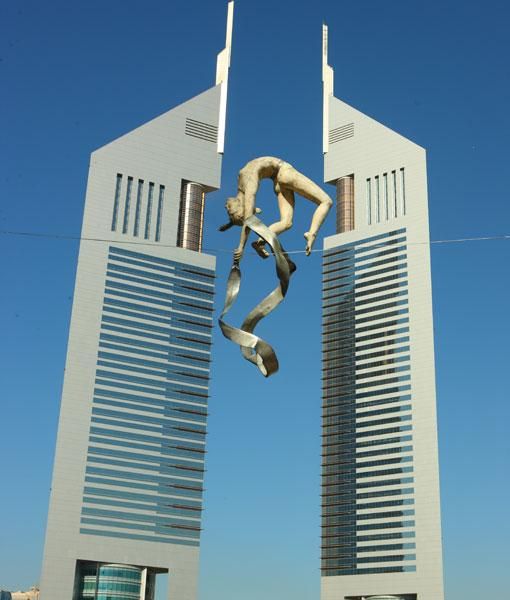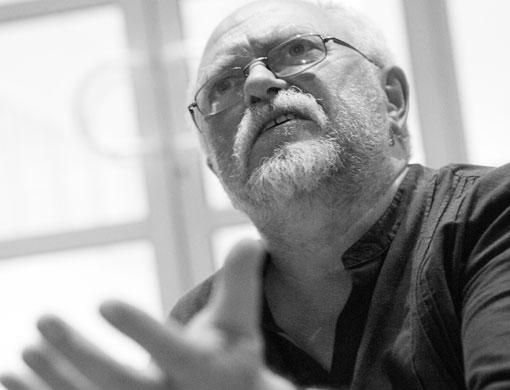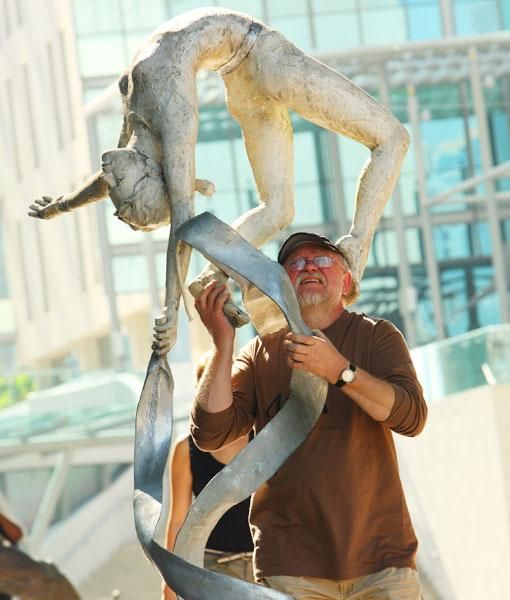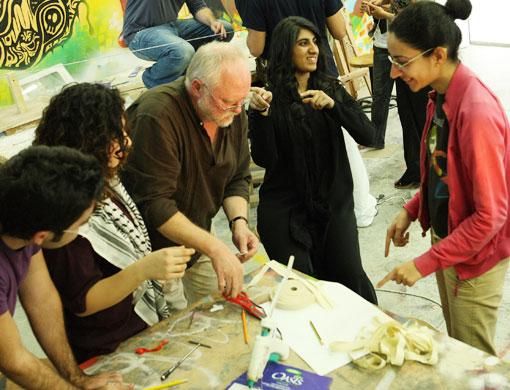Jerzy Kedziora's art is a balancing act of clever sculpture and the laws of physics. Having recently had an exhibition in Dubai he succeeded in suspending many a sceptic's disbelief. He talks to Zafar Ghori about his art of the air and the message behind it, which he insists belongs to the masses
From Michelangelo's David to the statue of Venus de Milo or the famous courtroom Lady Justice, man has produced some magnificent sculptures across history.
But have you ever heard of a sculpture suspended in air, balanced on a thin cord and staying there? World-renowned Polish sculptor Jerzy Kedziora (aka JOTKA) has taken sculpture one step further through his unique gravity defying, balancing act artwork that is not only magnificent to look at but is also premised on sophisticated kinetics. Come rain or shine, these sculptures never fall.
For the unveiling of his artwork in Dubai, JOTKA was a part of
'Under the Dubai sky – creating balance' exhibition held at The Gate Outdoors, Dubai International Financial Centre (DIFC) in November last year.
I
I was born in the suburbs of Czestochowa, southern Poland, which is home to the painting The Black Madonna placed in the monastery of Pauline Fathers and frequented by thousands of people from around the world. I believe that an artist is an artist from birth. It is an inbuilt talent that is nurtured by our experiences and interactions in life. It is a talent that surfaces when the time arrives.
My artistic talent is not a family trait. My father was an electrician and my mother used to knit woollen clothing for a living. I was the oldest of seven children. I used to draw designs on paper for my mother, which she would then integrate into her knitting patterns.
Her profession in a way, opened my eyes for the first time to the world of art. As I grew older, I began decorating churches, theatres and monuments in my city. I always felt that I was different from other children. Even as a child my art had put me in the limelight and I sometimes thought that I was abnormal because I was constantly being watched. I was greatly inspired by my best friend. His advice, views and criticism have affected my work most positively over the years.
My family features strongly in my sculptures. My son, daughter, daughter-in-law and grandchildren have all made an appearance in the sculpted form, balancing on cords. This is my way of showing that I care deeply for them. I only feature myself in my sculptures when there is a theme that could be controversial. In this way I am able to assume entire responsibility. My sculpture entitled The Silver Awakening features me.
I was devastated when my wife passed away two years ago. I moved away from the city and went back to the suburbs to grieve. She was an artist herself and I miss her so much. My memory of her influences my art in many ways. I dedicated a sculpture to her and placed it in the cemetery where she is buried. My passion for work after her death did not die. It was magnified.
I turned down numerous propositions from world-famous art galleries for the exclusive display of my work in their space despite the huge amounts of money offered, simply because I feel the rightful place of my art is in public view. I don't want it to be reserved exclusively for the privileged. I want the crowds to see my work, shake hands with me and appreciate my art.
Me
Me and my work
I work for pleasure. I often produce sculptures for the city by contributing to cultural monuments and museums, which is also my source of income.
I actively participate in exhibitions worldwide. I do not have a private clientele as I am not interested in making an exorbitant amount of money by making exclusive pieces for specific people. I want my art to be seen by the masses of the world. It is not designed to sit in a corner of some rich man's mansion.
Me and my balancing sculptures
Balancing sculptures is just one aspect of my main body of work. It is my invention. No other artist has ever tried to balance sculptures at one point on a cord. I was inspired by the skyscrapers of New York and Gothic architecture in Europe and what started out as a mere figment of my imagination has been made into a reality thanks to the aid of modern technology.
To balance these structures, I have made use of the forces of nature. It is more complex than it sounds. Through compasswork, I take into consideration the direction of the wind. The laws of physics come into play and help me to gauge the stability of the sculpture. Skill and workmanship are also very important. I feel these balancing sculptures have a very deep meaning and are not merely decorative pieces. I believe they stimulate people to think. I believe that society needs free thinkers.
Me and my contribution to hospitals
My balancing sculptures have been bought by hospitals in Germany. They use them as part of therapy for their patients with mental problems as they feel that their patients respond to them well.
Me and stability
There was a huge storm in Berlin where my sculptures were being exhibited. Trees were uprooted and houses destroyed but my sculptures were still balanced in the air after the storm was over. That should answer all questions I am posed about their stability.
Me and moments in Dubai
During the exhibition of my work at the DIFC, one of my sculptures, which resembles an acrobat on a hoop, was made to look like it was about to fall off. It was in fact an illusion. In the middle of the night somebody called the fire brigade to report this problem and the place was resonating with sirens until they understood that it would never fall off and left. I was quite amused by this!
Me and future endeavours
I am currently considering the use of optics in art. I am considering an idea that makes use of sunlight to produce a new kind of art. It is in the pipeline at the moment and I am in the process of finding a sponsor. I intend to call it 'The Optical Miracle'.
Me and work commitment
I would not refer to myself as a workaholic but I am passionate about my work. I do not love to work but I love my work when it's completed. Until my piece of art arrives at the point of looking the same as how I visualise it, I will not stop working on it. On a scale of one to 10, I would rate my commitment to work as 12.
Me and my critics
The world of art has to have its critics but I do not feel affected by them. Critics never delve deep into the artist's mind to truly consider what lies beneath the art; they tend to follow the trends of the art world at the time.
I think I am beyond my critics in every way. I am often criticised for exhibiting my work to the public as they feel I should reserve it for the supposed 'elite'.
Me and my inspiration
I am inspired by the time and place in which I am at any given point. I was once on a beach and I was so inspired by it that when requested to make something there, I made a huge shimmering glass tube above the waves. It was designed in such a way so that each tide would bring the water out of the glass at coordinated intervals. It is difficult to imagine; it was so beautiful.
Me and formal art training
I do not think it is absolutely necessary for an artist to have trained in an art school if he/she has the innate talent. Some things can't be taught. The school may teach technical details but can never teach that inner creativity that lies at the heart of truly great artworks. I have trained in two art academies but I don't think training is a guaranteed recipe for success.
Me and the students of AUD
I worked with six students from the American University in Dubai to create a sculpture and was very impressed by them.
I think it was telling that they were more interested in questioning me about the artwork and the meaning it held as opposed to focusing on how to balance structures. I feel they were true artists for doing so and I would like to work with them again. I was also proud of the purpose the sculpture was intended for as the proceeds from the auction went to the Dubai Autism Centre.
Me and Polish nationalism
At midnight on April 30 in 2004, one of my balancing sculptures entitled 'Crossing the river' was unveiled in the city of Bydgoszcz in front of thousands of people. It marked Poland's ascension into the European Union (EU). It is a balanced sculpture showing a man suspended above a river.
It symbolises Poland's entry into the EU and I am proud that it has come to represent a symbol of national pride and honour. I am very proud of this moment as I feel my contribution was a symbol of my patriotism and loyalty to my country.
I am happy when I see travel brochures in Poland listing sites to visit that display my work. I feel honoured that I am in my own way contributing to the tourism of my nation and the national economy.
Me and my family
My son and daughter are both artists. My son is a sensitive artist and I am proud that he is so. I feel men around the world
should be sensitive and understanding as this makes them strong. I have a lot of respect for my late wife as she gave up her profession to bring up our children. I will never forget that.
Myself
How has the life of an artist affected your perspective in your personal life?
I feel my art is a result of my personal life and not the other
way round.
Do you strive to make the world a better place through your work?
I have always brought political and global issues into my art and I hope to catalyse a positive effect by encouraging people to consider the messages behind my work.
If you could permanently place one of your works in one location in the world, where would it be and why?
Mount Everest, so that everybody comes to know about it.
What do you think of Dubai?
I feel very positive about this country. I saw the excitement on people's faces at the exhibition and I value the appreciation I received. Overall, I loved the experience.
– Zafar Ghori is a Sharjah-based freelancer















